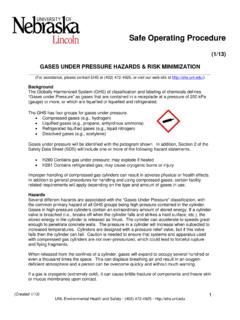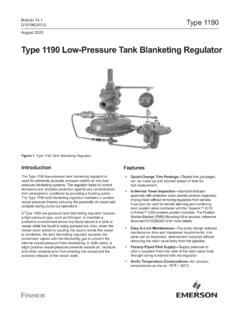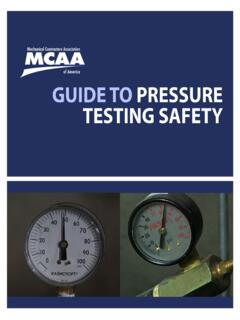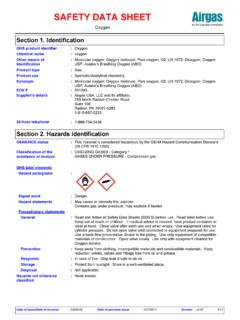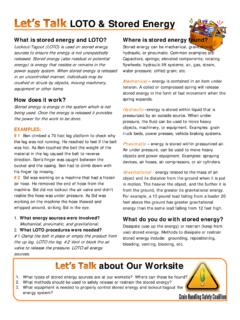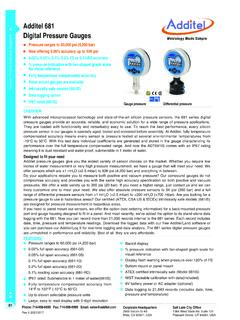Transcription of Construction Safety Pressure Testing (Hydrostatic ...
1 Construction Safety Consensus Guidelines The INGAA Foundation, Inc. Pressure Testing (Hydrostatic / Pneumatic) Safety Guidelines Document: CS-S-9 Revision: 0 Publication Date: September 2012 Page 1 of 7 ACTIVITY DESCRIPTION This document provides basic Safety guidelines for the Safety of all personnel and the general public during Pressure ( , hydrostatic, pneumatic) Testing operations. Plan and implement each Pressure - Testing event in a manner that mitigates unnecessary exposure to procedural hazards. All Pressure tests must be conducted with due regard for the Safety of life and property. All personnel have, and should use, "Stop Work" authority whenever there is concern for Safety during Pressure Testing operations.
2 This document is not meant to supersede or replace regulatory requirements, nor is it intended to be all inclusive of the applicable regulatory requirements. It is intended to be supportive and complimentary to such requirements. HAZARD ASSESSMENT Hazard assessments are performed to identify and mitigate perceived and actual environmental and operational hazards. A Job or Test Plan, including procedures and controls related to Safety , is prepared prior to conducting Pressure Testing . Hazard assessments are performed at the beginning of each shift. Review and update hazard assessments when: Each new task is begun. There is a change in how a task is performed.
3 Changes in site or environmental conditions occur. A specific need or concern is identified ( , as needed to ensure the Safety of personnel or property). ROLES AND RESPONSIBILITIES Management Responsibilities (includes all personnel with a supervisory role) Empower all personnel with the authority to Stop Work whenever hazardous conditions or potentially hazardous conditions are identified. Construction Safety Consensus Guidelines The INGAA Foundation, Inc. Pressure Testing (Hydrostatic / Pneumatic) Safety Guidelines Document: CS-S-9 Revision: 0 Publication Date: September 2012 Page 2 of 7 Provide for and require that signs, barricades or other protective barriers are placed in a manner and at a distance sufficient to demarcate a safe zone to protect personnel and the public from unanticipated Pressure release or equipment failure.
4 Provide for and require the installation of devices that mark the limits of the exclusion zone. Keep unauthorized personnel out of the test area. Inform all affected site and community personnel of the planned test. Provide for and require that equipment and materials are arranged to give unobstructed access/egress during Testing and in the event of an emergency. Establish lines of communication between the Owner/Facility, Contractor, and local authorities. Provide for and require the use of reliable transportation and communication systems during all aspects of the Testing event. Health & Safety (H&S) Responsibilities A Health and Safety Professional is involved with performing the hazard assessment.
5 Provide technical support for interpretation of Pressure Testing Safety guidelines. Evaluate the effectiveness of the job-specific Safety plan (or equivalent). Immediately stop and correct any Safety related non-compliant activities. Employee Responsibilities Do not enter or otherwise be present at a Pressure - Testing event unless you are part of the Testing team. Personnel performing the test should approach the pressured line only in the performance of their duties. Where possible, personnel should use Safety barriers for protection from the pressurized line and position the Testing equipment in such a manner so as to minimize potential hazards.
6 Review Safety requirements of the site-specific test plan (see Section ). Do not work over or near where Pressure Testing is being conducted. Wear the PPE as appropriate for the task being performed. Attend required training before working on the task (see Section 5). Report any non-compliant H&S activities to a Supervisor. Construction Safety Consensus Guidelines The INGAA Foundation, Inc. Pressure Testing (Hydrostatic / Pneumatic) Safety Guidelines Document: CS-S-9 Revision: 0 Publication Date: September 2012 Page 3 of 7 HAZARD MITIGATION General Suspend a test when the Testing personnel (including but not limited to: contractor, contractor s agents) or equipment are not working in a safe manner.
7 Consider the forces that would be present if any portion of the system failed while filling, under test, depressurizing or dewatering. Also consider potential for water hammer, potential for leakage of isolation valves, variable system pressures, potential for fill and dewatering pig velocity changes and other site specific conditions. When performing pneumatic tests, the piping shall be inspected to determine if the inside surfaces are contaminated with a combustible or flammable material ( , iron oxide, condensate). If found, remove such materials prior to air Testing . Never tamper with or tighten any fittings ( , connections, bolts, hoses) while component is under any Pressure .
8 Never tighten connections that are under Pressure . If a leak develops, you must depressurize to a safe level and then re-tighten. Wear hearing protection (which may include double hearing protection) that is adequate to reduce the noise below 80 decibels. The Pressure recorders and deadweight gauge shall be located at a safe distance least 100 feet from the facility being tested. General Worksite Safety Incorporate general worksite Safety precautions and procedures, as applicable. Verify that test equipment and materials are rated to withstand the test pressures. Verify that all supply lines and hose connections are secure with retaining devices before and during the test.
9 Visually inspect and ensure soundness and proper installation and valve positioning of all equipment used. Adequate lighting shall be available throughout Testing operations. Safety equipment and supplies should be readily available and should include, but are not limited to: Emergency spill kit. Fire extinguisher. Ladders. Mobile light plants. Whip checks. Construction Safety Consensus Guidelines Interstate Natural Gas Association of America Pressure Testing (Hydrostatic / Pneumatic) Safety Guidelines Document: CS-S-9 Revision: 0 Publication Date: September 2012 Page 4 of 7 Warning signs and barricades. Install mats or utilize secured ladders for access to test header valves.
10 If using mat bridges across the excavation, handrails must be installed if elevated 6' above a lower level. Restrain or otherwise secure fill and discharge lines and/or hoses. Verify the Pressure ratings of hoses, fittings, gaskets, and other manifold materials. Verify Pressure rating of facility being tested. Signage During Pressure Testing events, distinct warning signs, such as DANGER HIGH Pressure Testing IN PROGRESS must be posted at the test site and additional locations identified in the job specific Safety plan. When Testing in a populated area, an extensive public relations campaign ( , warning signs, barricade tape, strobe lights, and/or security guards) may be required to inform and protect the public from hazards associated with Testing activities.

